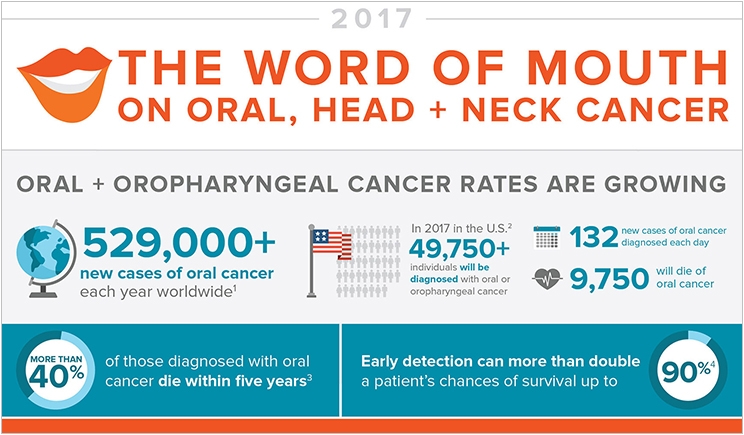
April is Oral Cancer Awareness Month, and dentistrytoday.com will be celebrating the event with blogs, news stories, and other features all spotlighting the disease. #OralCancerAwareness
The statistics from the Oral Cancer Foundation and the American Cancer Society are chilling:
- 49,750: The number of people who will be diagnosed with oral cancer this year in the United States.
- 132: The number of new oral cancer cases diagnosed each day.
- 1: The number of people who die every hour, every day, 365 days a year from oral cancer.
These figures are stark, and they represent lives cut too short or altered dramatically by the devastating impact of oral cancer.
Most cases of oral cancer are found in their late stages, resulting in an extremely high death rate. In fact, more than 40% of those diagnosed with oral cancer die within 5 years, due to late-stage diagnosis. In contrast, early detection (stage I and II) of oral cancer yields survival rates of up to 90%. Early detection is key to stopping the progression of the disease and minimizing the impact on those who are diagnosed.
Low Awareness
In the United States, awareness and education surrounding oral cancer is low. In observance of National Oral Cancer Awareness Month and Oral, Head and Neck Cancer Awareness Week this April, Vigilant Biosciences joined with the Head and Neck Cancer Alliance, the Oral Cancer Foundation, and Support for People with Oral and Head and Neck Cancer to launch a campaign to raise awareness about oral cancer and its risk factors. As part of this campaign, we announced findings from our 2017 Oral Cancer Awareness Survey, which polled more than 500 US adults on knowledge, perceptions, and preferences about oral cancer and oral cancer screening.
The survey revealed that a staggering 62% of adults in the United States know very little or nothing at all about the disease. The survey also showed how little US adults know about the various risk factors for oral cancer, particularly the connection between oral cancer and oral human papillomavirus (HPV), a common sexually transmitted disease. Plus, the Centers for Disease Control and Prevention reports that up to 70% of oropharyngeal cancers may be associated with HPV.
Additionally, the survey found that less than 5% of respondents discussed the relationship between HPV and oral cancer with their dental professional. However, once informed that HPV is the fastest growing risk factor for oral cancer (particularly in the oropharynx area), more than 50% of respondents stated that they would like to be screened more often for oral cancer.
On the Front Line
Whether they are performing a biannual cleaning or filling a cavity, dentists and dental hygienists are on the front line when it comes to all things oral health. As such, there are a number of ways in which dentists and dental hygienists can help increase awareness and educate their patients about oral cancer:
- Screen patients regularly: Both the ADA and American Dental Hygienists Association recommend that clinicians remain alert for oral cancer while performing routine visual and tactile examinations in all patients, but particularly in those who use tobacco or consume alcohol heavily. Our survey found that while only 29% report being screened at their last checkup, a vast majority of patients (81%) want to be screened for oral cancer at every dental visit.
- Discuss the risks with patients: Our survey reveals that 77% of US adults want their dental professional to help them learn more about how to reduce their risk for oral cancer. Dentists and dental hygienists should discuss all risk factors for oral cancer with their patients, particularly those that may not be as well known, such as exposure to the HPV virus.
- Adopt new, innovative technologies: The industry is innovating at a rapid pace, with new technologies emerging that can aid in the detection of oral cancer. It’s important to keep informed about new adjunctive diagnostic tools that, together with other clinical variables, may be able to help you detect oral cancer earlier, before it has progressed to a later stage.
Oral cancer is a growing issue. But through education and increased awareness, we as dental professionals can help patients become more proactive about their oral health and help save countless lives from this devastating and debilitating disease.
Mr. Kim founded Vigilant Biosciences in 2011 and serves as the company’s chairman and chief executive officer. As CEO, he has spearheaded the development and commercialization of the company’s first products, the OncAlert LAB Assay and the OncAlert Rapid Point-of-Care Test. Previously, he was involved with the founding of several startups, including the first spinoff company from the CDC and a strategic intellectual property asset management consulting group. He received his bachelor’s degree in biology from Washington University in St. Louis and his juris doctorate from Georgia State University, and he is licensed to practice law in Georgia and before the US Patent and Trademark Office.
Related Articles
Personal Journey Drives Cancer Innovation
Statistics Alone Don’t Reveal Oral Cancer’s Terrible Toll
Patients Want More Oral Cancer Education











